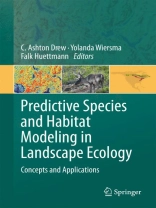Most projects in Landscape Ecology, at some point, define a species-habitat association. These models are inherently spatial, dealing with landscapes and their configurations. Whether coding behavioral rules for dispersal of simulated organisms through simulated landscapes, or designing the sampling extent of field surveys and experiments in real landscapes, landscape ecologists must make assumptions about how organisms experience and utilize the landscape. These convenient working postulates allow modelers to project the model in time and space, yet rarely are they explicitly considered. The early years of landscape ecology necessarily focused on the evolution of effective data sources, metrics, and statistical approaches that could truly capture the spatial and temporal patterns and processes of interest. Now that these tools are well established, we reflect on the ecological theories that underpin the assumptions commonly made during species distribution modeling and mapping. This is crucial for applying models to questions of global sustainability.
Due to the inherent use of GIS for much of this kind of research, and as several authors’ research involves the production of multicolored map figures, there would be an 8-page color insert. Additional color figures could be made available through a digital archive, or by cost contributions of the chapter authors. Where applicable, would be relevant chapters’ GIS data and model code available through a digital archive. The practice of data and code sharing is becoming standard in GIS studies, is an inherent method of this book, and will serve to add additional research value to the book for both academic and practitioner audiences.
表中的内容
Acknoweldgements.- Forword by Jack Liu.- List of Contributors.- List of abbreviations.- Introduction.- Chapter 1. Landscape modeling of species and their habitats: history, uncertainty, and complexity (by Yolanda Wiersma, Ashton Drew, Falk Huettmann).- Section 1. Current State of Knowledge.- Chapter 2. Integrating Theory and Predictive Modeling for Conservation Research (by Jeremy T. Kerr, Manisha Kulkarni, and Adam Algar).- Chapter 3. The State of Spatial and Spatio-Temporal Statistical Modeling (by Mevin B. Hooten).- Section 2. Integration of Ecological Theory into Modeling Practice.- Chapter 4. Proper Data Management as a Scientific Foundation for Reliable Species Distribution Modeling (by Benjamin Zuckerberg, Falk Huettmann, and Jacqueline Frair).- Chapter 5. The Role of Assumptions in Predictions of Habitat Availability and Quality (by Edward J. Laurent, C. Ashton Drew, Wayne E. Thogmartin).- Chapter 6. Insights from Ecological Theory on Temporal Dynamics and Species Distribution Modeling (by Robert J. Fletcher, Jr., Jock S. Young, Richard L. Hutto, Anna Noson, and Christopher T. Rota).- Section 3. Simplicity, Complexity, and Uncertainty in Applied Models.- Chapter 7. Focused Assessment of Scale-Dependent Vegetation Pattern (by Todd R. Lookingbill, Monique E. Rocca, and Dean L. Urban).- Chapter 8. Modeling Species Distribution and Change Using Random Forest (by Jeffrey S. Evans, Melanie A. Murphy, Zachary A. Holden, and Samuel A. Cushman).- Chapter 9. Genetic Patterns as a Function of Landscape Process: Applications of Neutral Genetic Markers for Predictive Modeling in Landscape Ecology (by Melanie A. Murphy and Jeffrey S. Evans).- Chapter 10. Simplicity, Model Fit, Complexity and Uncertainty in Spatial Prediction Models Applied Over Time: We Are Quite Sure, Aren’t We? (by Falk Huettmann and Thomas Gottschalk).- Chapter 11. Variation, Use, and Mis-use of Statistical Models: a Review of the Effects on the Interpretation of Research Results (by Yolanda F.Wiersma).- Chapter 12. Expert Knowledge as a Basis for Landscape Ecological Predictive Models (by C. Ashton Drewand Ajith H. Perera).- Section 4. Designing Models for Increased Utility.- Chapter 13. Choices and Strategies for Using a Resource Inventory Database to Support Local Wildlife Habitat Monitoring (by L. Jay Roberts, Brian A. Maurer, Michael Donovan).- Chapter 14. Using Species Distribution Models for Conservation Planning and Ecological Forecasting (by Josh J. Lawler, Yolanda F. Wiersma and Falk Huettmann).- Conclusion.- Chapter 15. The state of habitat and species modeling today (by Ashton Drew, Yolanda Wiersma, Falk Huettmann).












